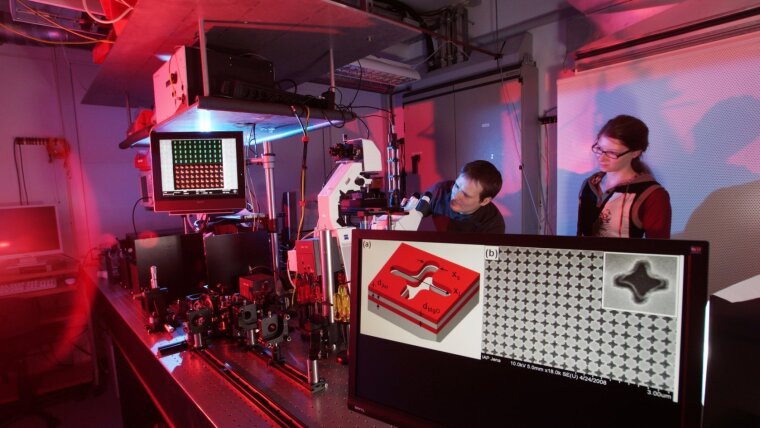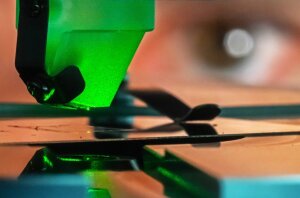
Thomas PERTSCH
Image: PrivateProf. Dr. Thomas PERTSCH
Email: thomas.pertsch@uni-jena.de
Phone: +49 3641-9-47560
Prof. Pertsch is a member of the board of directors of the Abbe Center of Photonics and the spokesman of the Abbe School of Photonics. He is a fellow of the Max Planck School of Photonics and associated investigator in the clusters of excellence “Balance of the Microverse” and “Transformative Meta-Optical Systems”. He serves in the board of directors of the Thuringian Innovation Center for Quantum Optics and Sensing and is the head of the Nano & Quantum Optics Group at the Institute of Applied Physics.
The Nano & Quantum Optics group targets to explore and understand the properties of nanoscale matter and their interaction with nontrivial photon states. The group's field is a rapidly developing research area that deals with the generation, propagation, manipulation, and detection of photons in nanostructures, with characteristic dimensions far below the scale of the wavelength of light. The generation, spread, and localization of photons and complex multiphoton states on such small length scales is a challenging topic, which the group explores by a broad range of methods. Hence, fundamental effects in nanostructured materials and quantum photonic systems are studied by a coherent approach of scientists in theory, technology, and experimental characterization directly within the group as well as by collaborating within multiple international networks.
Beside our strong commitment to explore the fascinating fields of nano and quantum optics, further research directions of the group address several other photonics-related topics. On the one hand, we study fundamental science phenomena such as linear and nonlinear properties of metamaterials, photonic crystals, optical microresonators, and spatio-temporal dynamics in discrete optical systems. On the other hand, we are strongly engaged in application-oriented research fields, where we investigate, e.g., innovative approaches in near-field microscopy, quantum imaging, nonlinear imaging and spectroscopic techniques for biological specimen, and photon management in solar cells.
Research Areas
Prof. Pertsch’s research targets the control of light at the nanoscale and at the quantum level using nanostructured materials and ultrafast nonlinear optical effects. Research interests include:
- Ultrafast light-matter interactions and optical quantum phenomena in nanostructured matter, as e.g. photonic nanomaterials, metamaterials, photonic crystals, and 2D semiconductors (TMDCs)
- Nonlinear spatio-temporal dynamics, plasmonics, near field optics, high-Q nonlinear optical microresonators, opto-optical processes in integrated optics, and alloptical signal processing
- Integrated quantum optics, quantum imaging, and quantum sensing
- Multi-tip scanning nearfield optical microscopy (SNOM) and photoemission electron microscopy (PEEM)
- Application of photonic nanostructures for multifunctional diffractive optical elements, for efficiency enhancement of photovoltaic elements, and for astronomical instruments
Teaching Fields
Prof. Pertsch’s teaching is devoted to the early involvement of young scientists in modern research topics. He gives Masterlevel courses in:
- Fundamentals of modern optics
- Computational methods in physics and photonics
- Introduction to nano optics
- Photonic quantum technology
- Innovation methods in photonics
Research Methods
The laboratory run by Prof. Pertsch offers a wide range of methods for the experimental characterization of photonic nanostructures, which include:
- Scanning nearfield optical microscopy (SNOM)
- High-resolution micro-spectroscopy (UV-VIS-IR)
- Time-resolved single photon detection and correlation
- Photoemission electron microscopy (PEEM)
- Ultrafast time-resolved characterization of nonlinear spatio-temporal dynamics
Recent Research Results
Exploring nonlinear light-matter interactions at the nanoscale to tailor the quantum properties of light requires also research on novel experimental methods, like superfocusing scanning nearfield optical microscopy.
Image: Jens Meyer (University of Jena)The Nano & Quantum Optics Group studies the nonlinear interaction of light with nanostructured matter [1]. Our research ranges from the single photon level to ultrahigh intensities, from the XUV to the MIR, from ultranarrow linewidth to few cycle fs pulses. Despite this diversity, our research has in common, that modifying the geometry of matter at the nanoscale allows to control fundamental interactions, giving rise to new phenomena for extreme excitation parameters. Our research approach incorporates a comprehensive range of methods, from theory, numerical modelling, nanotechnology, to experimental characterization.
Together with our major collaborators from within the ACP and the Australian National University, the Université de Paris, the National Central University Taiwan, the Lomonosov Moscow State University, as well as the Karlsruhe Institute of Technology, we could recently achieve exemplary demonstrations of the strength of networking to achieve breakthroughs in fundamental science, e.g.: merging top-down and bottom-up approaches to fabricate artificial photonic nanomaterials with a deterministic electric and magnetic response [2], disorderinduced phase transitions in the transmission of dielectric metasurfaces [3], hybrid dielectric metasurfaces for enhancing second-harmonic generation in chemical vapor deposition grown MoS2 monolayers [4], pinhole quantum ghost imaging [5], or ultrafast all-optical tuning of direct-gap semiconductor metasurfaces [6]. Our fundamental expertise on the optical properties of nanostructures also allows us to operate an application-oriented research stream with several international industry partners on the basis of joint PhD projects. Recent results of these collaborations include: hybrid refractive holographic single vision spectacle lenses [7], dispersionengineered nanocomposites enable achromatic diffractive optical elements [8], sub-micrometer nanostructure-based RGB filters for CMOS image sensors [9], or flat optics in high numerical aperture broadband imaging systems [10].
[1] Pertsch and Kivshar, MRS Bulletin 45, 210 (2020).
[2] Dietrich et al., Adv. Funct. Mater. 30, 1905722 (2020).
[3] Rahimzadegan et al., Phys. Rev. Lett. 122, 015702 (2019).
[4] Löchner et al., ACS Photonics 8, 218 (2020).
[5] Vega et al., Appl. Phys. Lett. 117, 094003 (2020).
[6] Shcherbakov et al., Nat. Comm. 8, 17 (2017).
[7] Trapp et al., J. Eur. Opt. Soc. - Rapid Publ. 15, 14 (2019).
[8] Werdehausen et al., Optica 6, 1031 (2019).
[9] Berzins et al., ACS Photonics 6, 1018 (2019).
[10] Werdehausen et al., Journal of Optics 22, 065607 (2020).
Link to the Nano & Quantum Optics Group at the Institute of Applied Physics

